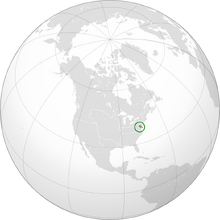Fatti maschii, parole femine (Latin) ("Manly deeds, womanly words") | |||||||
| Anthem | "Maryland, My Maryland" | ||||||
| Capital | Annapolis | ||||||
| Largest city | Baltimore | ||||||
| Other cities | Georgetown, Salisbury | ||||||
| Language official |
English | ||||||
| others | Irish, Pennsylvania Dutch | ||||||
| Religion main |
Catholicism | ||||||
| others | Judaism, Protestantism | ||||||
| Demonym | Marylander | ||||||
| Government | Unitary presidential constitutional republic | ||||||
| Legislature | General Assembly | ||||||
| President | Martin O'Malley | ||||||
| Area | 32,310 km² | ||||||
| Population | 6,446,285 | ||||||
| Independence | from Great Britain | ||||||
| declared | July 4, 1776 | ||||||
| recognized | 1790s | ||||||
| Currency | Dollar (MDD)
| ||||||
| Internet TLD | .md | ||||||
The Free State of Maryland, colloquially known as Maryland, is an independent nation located along the Atlantic coast of North America. Maryland is bordered by Pennsylvania to the northeast and Virginia to the southwest. Maryland is hydrographically dominated by the Chesapeake Bay, which bisects the nation between the Eastern Shore and the Western Shore.
Maryland was established in 1632 as a proprietary colony for the Barons of Baltimore and was intended to become a haven for English Catholics during a time when religious persecution was common in Europe. Maryland became an early bastion of religious tolerance within the New World, but religious strife within the colony resulted in rebellion in the late 1600s. Religion also played a key role in the boundaries of the colony, with neighboring Delaware being granted to Quaker-dominated Pennsylvania. These boundaries became official in the 1760s when surveyors Charles Mason and Jeremiah Dixon were hired to survey what would become known as the Mason-Dixon Line (which continues to mark the boundary between Maryland and Pennsylvania).
Maryland became an active and early supporter of the American Revolution and (along with the other Thirteen Colonies) declared independence from Great Britain on July 4, 1776. Maryland played a key role within the early governments of the United States of America, including housing the Continental Congress on several occasions. Marylander John Hanson became the first President of the Continental Congress to hold a full term in office.
Following the failures of the Constitutional Convention of 1787, Maryland withdrew from the United States of America in 1788 (shortly before the union dissolved), beginning the period of Maryland's full independence. Throughout the 19th century, Maryland acted as a buffer state between Pennsylvania and Virginia, retaining both positive and distant relations with both. Maryland has retained closer relations with the United Kingdom and later New Netherland to act as counterweights between its more powerful neighbors.

Atlas of Maryland.
Maryland continued to practice slavery for much of the 19th century. This practice gradually ceased by the later half of the century as the economy began phase out slavery. Maryland becoming the only southern American Republic to abolish slavery without any economic or political turmoil (as was the case in Carolina and Virginia). From the early 20th century onward, Maryland has become one of the wealthiest nations in North America. Much of the economy is dominated by farming and fishing, with the Chesapeake blue crab becoming a national icon.
Maryland has become of the the most densely populated nations of the New World. More in line with the northern American Republics, Maryland has a highly diverse population — with Germans and Irish making up the largest ancestral groups of the nation. Catholicism is the largest religious body within the nation (continuing its religious origins), with Protestantism not being to far behind. Judaism is the largest non-Christian religion within Maryland.
| |||||



